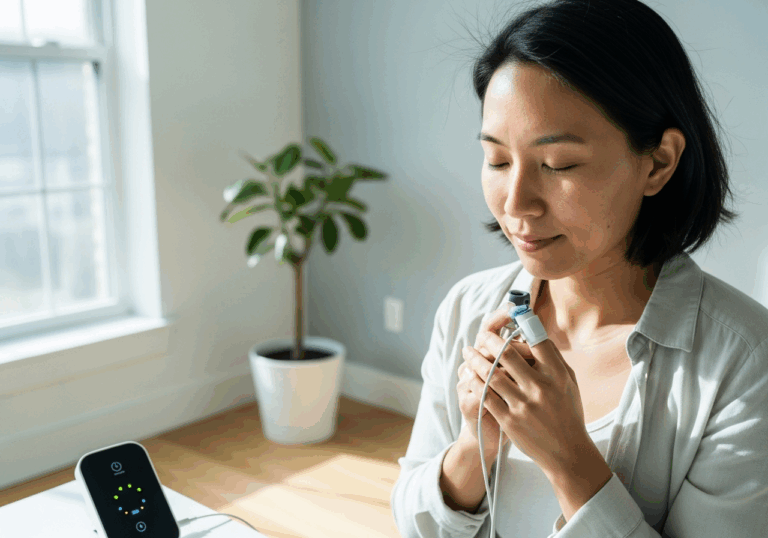Science-Backed Tips
Boost Your Mood with Breathing Techniques
20-30% increase in heart rate variability with 10-minute sessions
📊 Did you know?
💡 Why It Matters
1️⃣
Improving SDNN by 20-30% can enhance autonomic flexibility, crucial for stress management.
2️⃣
A reduction of 5 bpm in resting heart rate can lead to lower cardiovascular risk over time.
3️⃣
Regular breathing practice can significantly improve mood stability and emotional resilience.
✅ Try These Micro-Tips
🎯
Practice deep slow breathing for 10 minutes, twice daily.
🎯
Inhale deeply for 6 seconds, hold for 2 seconds, then exhale for 6 seconds.
🎯
Incorporate breathing sessions into your morning and evening routine.
🎯
Track your heart rate and mood changes over a month to observe improvements.
📚 The study
Participants engaged in twice-daily sessions of 6 breaths per minute for just 10 minutes, and the results were remarkable.
Not only did this practice lead to sustained improvements in heart rate variability (SDNN) by an impressive 20-30%, but it also resulted in a decrease of approximately 5 beats per minute in resting heart rate.
These changes are crucial as they enhance autonomic flexibility, a vital component for effective stress management.
Furthermore, the reduction in resting heart rate can contribute to lower cardiovascular risk over time, making this breathing technique a valuable tool for maintaining heart health.
Beyond the physiological benefits, regular practice of deep, slow breathing has been shown to bolster mood stability and emotional resilience, allowing individuals to navigate life’s challenges with greater ease.
This study underscores the importance of integrating breathing exercises into daily routines, as they can significantly enhance overall well-being and promote a healthier lifestyle.
By dedicating just a few minutes each day to this practice, individuals can cultivate a sense of calm and improve their emotional robustness, ultimately leading to a happier and healthier life.
❓ Frequently Asked Questions ❓
Learn more
What is SDNN and why is it important?
SDNN stands for the standard deviation of normal-to-normal intervals, which reflects heart rate variability. It is important because higher SDNN indicates better autonomic flexibility, crucial for managing stress and overall well-being.
How does deep slow breathing affect heart rate?
Deep slow breathing can reduce resting heart rate by approximately 5 bpm. This reduction can lead to lower cardiovascular risk over time.
What is the recommended duration and frequency for deep slow breathing sessions?
It is recommended to practice deep slow breathing for 10 minutes, twice daily. This routine can enhance mood stability and emotional resilience.
What are the steps for practicing deep slow breathing?
To practice deep slow breathing, inhale deeply for 6 seconds, hold for 2 seconds, and then exhale for 6 seconds. This structured approach helps in achieving physiological calm.
How long does it take to see improvements from deep slow breathing?
Participants in the study observed improvements in SDNN and resting heart rate over the course of one month. Consistent practice is key to experiencing these benefits.
Can deep slow breathing improve mood?
Yes, regular deep slow breathing practice can significantly improve mood stability and emotional resilience. This is achieved through physiological calm and enhanced autonomic flexibility.
What is the significance of a 20-30% increase in SDNN?
An increase in SDNN by 20-30% indicates enhanced autonomic flexibility, which is crucial for effective stress management. This improvement can lead to better overall mental and physical health.
How can I track the effects of deep slow breathing on my health?
You can track your heart rate and mood changes over a month to observe improvements. Keeping a journal or using a health app can help in monitoring these changes effectively.
Is deep slow breathing suitable for everyone?
Deep slow breathing is generally safe and beneficial for healthy adults. However, individuals with specific health conditions should consult a healthcare professional before starting any new practice.
What are the long-term benefits of incorporating deep slow breathing into my routine?
Incorporating deep slow breathing into your routine can lead to sustained improvements in heart rate variability and mood. Over time, these benefits can contribute to lower stress levels and reduced cardiovascular risk.





